Welcome to the eleventh installment of my article series, Track Breakdowns.
In this series, I look at the theory and arrangement behind popular songs, ultimately showing you what makes each song work.
In this breakdown, we’ll look at Louis The Child’s track Better Not, featuring Wafia.
After receiving a ton of requests to cover a Louis The Child song, I finally bit the bullet and broke down one of their tracks.
I chose Better Not because it exemplifies many of the songwriting techniques Louis The Child uses throughout their catalouge.
The duo does an amazing job crafting radio-ready hits that cross over between pop and dance music crowds.
Their tracks are very pop-friendly, but done with taste and subtlety that sets them apart from artists in a similar space.
Let’s looks at a few of the songwriting techniques Louis The Child uses in this song, ultimately looking at how you can incorporate them into your own arrangements.
Get 25 high-quality MIDI chord progression files for free 🎹
Our Track Breakdown MIDI Vault is packed with chord progression MIDI files from songs like Mura Masa’s ‘Lovesick’, Flume’s ‘Say It’ & more! 👇
The Sauce
Better Not is in the key of E major.
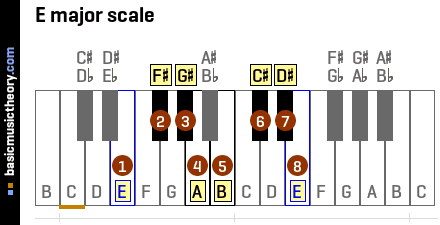
The track cycles between two different chord progressions, which you can see a map of below.

The first progression is E – B – A, which numerically is I – V – IV.
- E: E – G# – B
- B: B – D# – F#
- A: A – C# – E
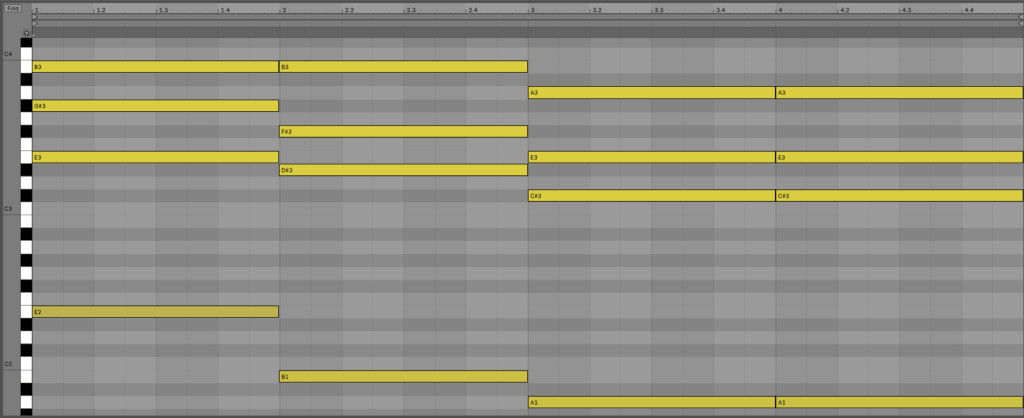
Pretty straightforward.
The second progression is G#m – B – E, which is iii – V – I.
- G#m: G# – B – D#
- B: B – D# – F#
- E: E – G# – B
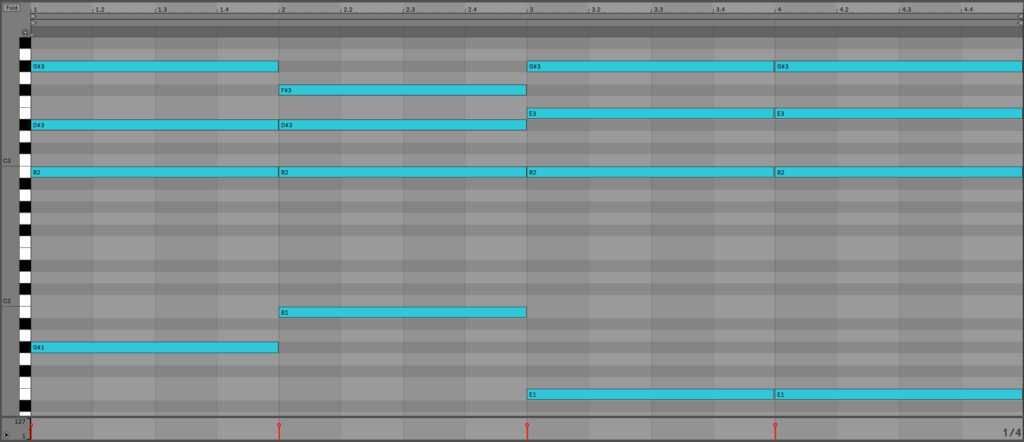
Again, pretty straightforward.
Now, let’s look at how they were able to take these two basic progressions and present them in an interesting and memorable way.
1. Implied Chords
The first thing we need to talk about is implied chords.
Although this track uses the two chord progressions I showed you above, we never hear them in their full form.
Listen back to the start of the track. There isn’t a full chord progression playing, just a melody and a bass.
Although the full chords aren’t present, the chords are being implied by the bass, creating what are called implied chords.
If you read my Madeon Track Breakdown, you should already be familiar with the concept of implied chords.
The idea behind implied chords is that you don’t need to play all of the notes in a chord to get the quality of the chord across.
You can omit certain notes to play with the texture and feel of your progression.
Moreover, you can also use a bassline to imply a chord progression.
Even if you’re playing just the root note of a progression, the listener will naturally “fill in” the notes above the chord relative to the key that you’ve established with your track.
This is exactly what Louis The Child does in Better Not.
Other then a brief stint in the final chorus, this track never uses a full chord progression. Rather, it uses a series of basslines to imply a progression.
For example, here is a transcription of the intro melody and bassline.
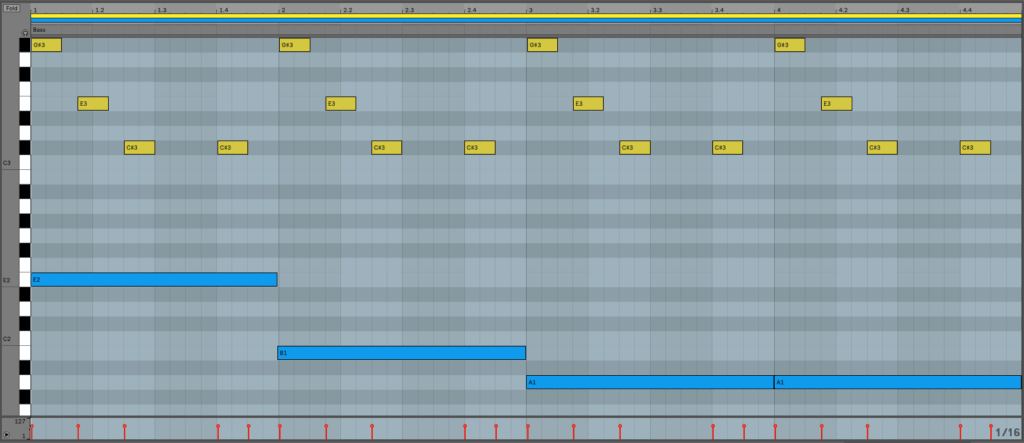
The bassline is playing E – B – A.
If we fill out these chords in the key of E major, we’ll get E major, B major, and A major.
Even though the chords are left “empty” in the track, the listener still fills in the blanks.
Here’s the melody with the full voiced chords:
The character and feel is quite similar to the example above with just the melody and baseline.
By leaving out these chords, Louis The Child achieves a few things:
- They tease out the full quality of the chords. While the full-voiced progression is quite (in my opinion) bright and cheesy, playing just the bass notes helps disguise this progression.
- They keep the track airy and open. There is less information to overwhelm the listener.
As I mentioned above, they more or less never use a full-voiced chord progression in this song. Rather, they cycle between different basslines that imply two seperate chord progressions.

Bass 1:
Bass 2:
How can you apply this information?
More than anything, don’t think you need a full chord progression playing at every moment in a track.
You can use a bassline to imply a chord progression, which will provide harmonic movement to push the track forward, all while keeping your track open and airy.
Analyze your favorite tracks and dissect if and when they use this implied chord technique.
2. Switching Progressions
In Better Not, Louis The Child cycles between two different chord progressions:
Progression 1: I – V – IV (E – B – A)
Progression 2: iii – V – I (G#m – B – E)
When they move from Progression 1 to Progression 2, they use a technique called tonic substitution.
Tonic Substitution: The use of chords that sound similar to the tonic chord (or I chord) in place of the tonic. In major keys, the chords iii and vi are often substituted for the I chord, to add interest. (via the wikiwiki)
The application of this technique is simple.
If your chord progression starts on the I, and you want to switch to a different chord progression, start the new progression on the iii or the vi.
These chords sound similar because they share several common tones, which are simply notes the two chords have in common.
The I chord in this song is E major (E – G# – B), which has two notes in common with the three chord G#m (G# – B – D#).
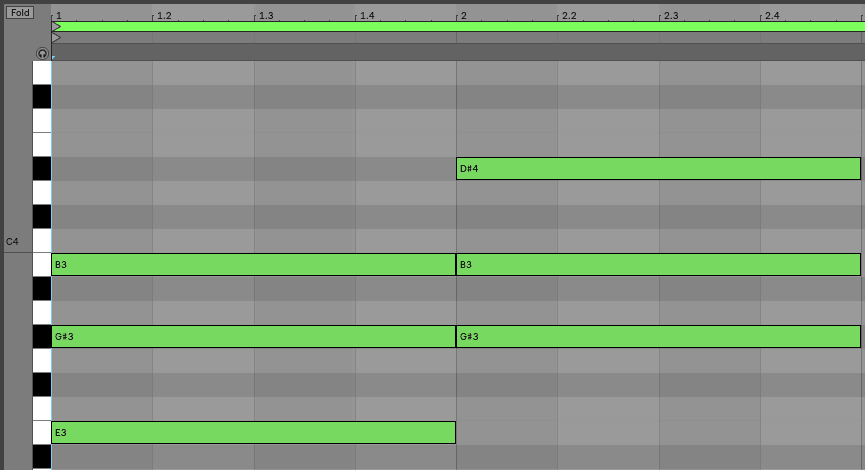
E vs. G#m
Since these two chords sound similar, the transition between the progressions feels natural.
Take a listen to Progression 1 followed by Progression 2:
That’s all there is to tonic substitution.
It’s a simple and effective technique to switch between chord progressions.
3. Disguising Simplicity
This track does an amazing job balancing simplicity and complexity.
Better Not as whole is quite energetic and dynamic.
There is a bright poppy vocal, strong instrumentation, as well smooth transitions between contrasting sections.
However, at any point in time, there isn’t a whole lot going on in the track.
For example, there are only 4-5 elements in the verse: a vocal, a bassline, a steel drum melody, and a clap and hi-hat.
That’s it.
In our recent podcast interview with KRANE, he talked about how the main difference between professionals and amateurs is that amateurs simply have too many elements in their tracks.
Every element you add to a project file pulls away focus from what’s already there.
Focus on crafting your core elements to be as clean and catchy as possible before you pile additional elements on top.
Better Not is a perfect example of how simple doesn’t have to mean boring.
The more you can achieve with less, the easier your track will be to digest.
Odds are this isn’t the first time you’ve heard this advice, but let this give you some extra motivation to strip down your music to what really matters.
Find what you’re trying to say with your music, and say it as simply as possible.
4. Teasing the Melody
Your job as a songwriter is to create development that feels new but familiar.
An easy way to do this is to tease your main chorus melody in an earlier section.
For example, in Better Not, the melody in intro is also the primary melody in the pre-chorus.
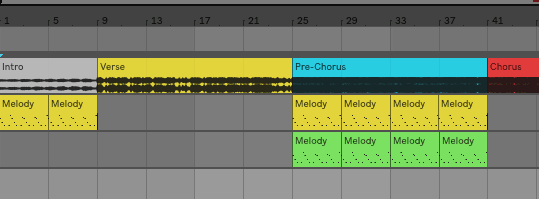
In the intro, the melody is played by a vocal pluck. In the pre-chorus, the steel pan from the verse picks up that same melody, while the vocal pluck follows underneath.
For some of you, this might be a new concept.
For others, this concept is old news.
If you fall into the latter category, I encourage you to experiment with more interesting ways to tease out a melodic idea or hook.
Most producers will either just filter that melody in (which is overly predictable), or they’ll “preview” it in the verse using the same instrument.
You should experiment with more unique and creative ways to preview an idea.
You can transpose the MIDI up or down an octave, add subtle embellishments to the melody, or change up the instrument altogether.
As long as there is some link between the previewed and full idea, the transition will feel smooth and familiar.
In other words, stop falling into the same old 2012 habits and look for more interesting ways to create variation and interest in your music.
5. Stacking Hooks
One thing I love about Louis The Child and their multiple successful side-projects is that their music is riddled with hooks.
Within the past few decades, popular music has gotten to a point where nearly everything is a hook.
Listen to any Calvin Harris song and you’ll know exactly what I’m talking.
There isn’t just one hook that grabs your attention, there are several hooks that try to weave their way into your subconscious.
From a marketing perspective, this makes complete sense.
More hooks means more things to remember a song by, which increases the chance that you’ll play it again or show it to a friend.
While not for all styles of music, this method of songwriting has heavily shaped popular music.
Louis The Child does this in most of their songs, and this track is no exception.
They weave through different melodies in Better Not, all while keeping the focus on the main vocal.
This creates an arrangement that’s dynamic and exciting but not too overwhelming.
The melodies themselves aren’t too complex either.
I already introduced you to the intro and pre-chorus melody.

This melody is essentially just playing on a C#m chord (C# – E – G#), with embellishments at the end of each bar (those B and A notes).
Let’s briefly look at the other melodies in this track.
Here is the the steel-pan melody used in the verse.
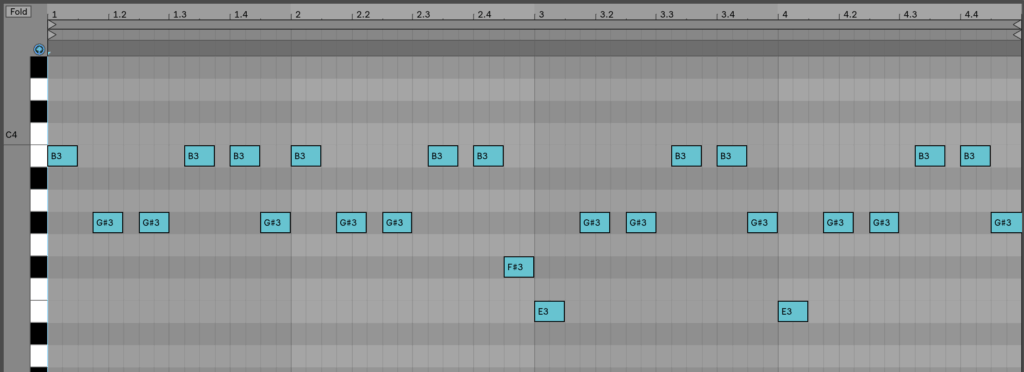
Again, this melody is pretty simple. This time through, it’s more or less riffing on an E major chord (E- G# – B).
The static rhythm helps tuck it under the vocal, making sure the listener’s attention isn’t split.
Next up, we have the chorus melody.

Take a listen to it in the original.
Again, this melody is relatively straightforward.
At the start of each bar there is a quick flutter that gets balanced out by the static E to G# 1/8th note rhythm.
The initial quick flutters are more or less spelling out different chords.
The first four notes are G#, B, D#, and E, which spells out an Emaj7 chord (E-G#-B-D#).
(If you’re curious, the flutter in Bar 2 spells out a B major chord, and in Bar 3 spells out a C#m chord).
As for the E-G# movement, these are just the root and the third in the key of E major, so they sit nicely against everything else in the track.
While these melodic ideas are quite simple, there are three ways that Louis The Child keeps these melodies from sounding stale.
First off, they don’t stay on one melody for too long.
If they took that intro melody and played it throughout the entire song, you’d be sick and tired of it by the end of the track.
The same goes for any of the other melodies used in this song.
Louis The Child cycles between several motifs in this track, which keeps the movement fresh and exciting.
Below is an overview of the melodic development in Better Not.

See what I mean?
We’re never shown any of these melodies long enough to get bored of them.
In other words, your arrangement doesn’t need to be complex to be interesting.
As a producer, you don’t want the listener to feel inclined to skip through your track because it’s boring and repetitive.
Focus on crafting arrangements that progress the song in a natural, familiar way.
Now this is the first way that Louis The Child kept these melodies from sounding stale.
Let’s discuss two other ways they kept and held your attention in this song.
6. Countermelodies
Louis The Child uses a few simple but effective counter melodies in Better Not.
In the second half of the first chorus, they introduced two very simple counter melodies. The first is played by a string/xylophone layer, and the second is a played by a hard panned square wave.
Counter Melody 1:
Counter Melody 2:
You can see the MIDI below.

Counter 1 in blue, Counter 2 in red
Take a listen to the original, and try to pick them out.
Although subtle, these countermelodies add just enough energy to push the chorus forward.
Another melody is introduced during the bridge, which serves as a countermelody in the final chorus.
Take a listen:

Listen to it in the original below:
Yet again, a relatively simple melody.
The static rhythm tucks this melody under the vocal, while the recycled vocal pluck sound keeps the transition from sounding abrupt.
This is an example of how Louis The Child recycles both melodies and instruments throughout this track to create a steady, consistent development.
Rather than trying to do too much or too little with the arrangement, Better Not hits that sweet spot between variation and repetition.
7. Dynamic Movement
The third way Louis The Child pushes the melodic development in this track is with dynamic movement, or in other words, automation.
Here’s a beautiful quote from Hyperbits (via the free Music Production Handbook) that summarizes the importance of movement in a mix:
“I love creating movement in ALL forms. For me, I can simplify the entire music production process as an attempt to make overly- digital and overly-clean computer stuff sound human and real. This means making things imperfect. This means playing with auto-panners and tremolos and auto-filters (basically the entire Soundtoys bundle) until my mix has this kind of x-factor to it. It starts to jump and pop and move and dance and feel the opposite of rigid. That, to me, is the most fun part of music production…making it sound real.” – Hyperbits
As I dissected Better Not for this breakdown, I continued to pick out subtle amounts of automation and variation throughout this mix.
As Hyperbits mentioned, movement adds life and character to a mix. Without it, your music will sound just as stale as every other producer on Soundcloud begging for a repost.
Listen to the track, and look for these three instances of automation:
- 0:01-0:15: Both the vocal pluck and the bass have a small amount of filter cutoff automation that opens up that section into the verse. It’s very smooth, and not the least bit jarring.
- 0:15-0:30: Notice how the noise layer slowly filters in during the first half of the verse. Also, notice how they add a more “hifi” noise layer that picks up the energy in the second half of the verse. Again, these are subtle, but effective techniques.
- 1:33, 2:40, and 3:14: In the first and second choruses, the square wave countermelody is panned to the left. In the final chorus, it’s panned to the right.
I think this is a concept that producers are beginning to understand, but neglect to incorporate into their workflow.
Whether it’s laziness or forgetfulness, these are the things that separate the pros from amateurs.
It’s up to your to reshape your workflow, adding life and character to your mix with automation.
For example, I love automating the Dry/Wet on OTT to add movement during my choruses. I’ll throw it on one of my lead instruments, adjusting the automation amount to taste (normally between 5% and 20%). This helps shift the dynamics of the track in a way that’s subtle but extremely effective.

Ditch the filter cutoff automation, and experiment with all types of automation to add more movement and character to your music.
Want free access to the Track Breakdown MIDI Vault? You can download the MIDI from all of our Track Breakdowns, as well as 25 hi-quality MIDI chord progressions you can use in your own productions.
Get 25 high-quality MIDI chord progression files for free 🎹
Our Track Breakdown MIDI Vault is packed with chord progression MIDI files from songs like Mura Masa’s ‘Lovesick’, Flume’s ‘Say It’ & more! 👇
Conclusion
I hope you were able to take away some useful tips and techniques from this article.
I tried to pull out as much valuable information as I could from this song, helping you to better understand what makes a great song, great.
Lastly, if there are any songs you’d like covered, please let me know!
Want to read more breakdowns? Click here to visit the Track Breakdown Glossary.


